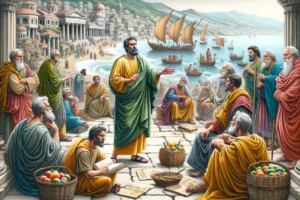
The Conversion of Saul (Paul)
The conversion of Saul, who later became known as Paul, is a significant event in the New Testament, illustrating a dramatic transformation from a persecutor of Christians to one of the foremost apostles of Christianity. This story is detailed in Acts 9:1-19.
Quick Facts:
- Saul’s Mission: Saul was on his way to Damascus to arrest followers of Jesus, armed with letters from the high priest authorizing him to bring them bound to Jerusalem.
- Divine Encounter: On the road to Damascus, a bright light from heaven suddenly surrounded Saul, and he fell to the ground.
- Voice of Jesus: Saul heard a voice saying, “Saul, Saul, why do you persecute me?” Identifying Himself as Jesus, whom Saul was persecuting.
- Temporary Blindness: When Saul got up from the ground, he was blind and had to be led by the hand into Damascus.
- Ananias’ Vision: The Lord appeared in a vision to Ananias, a disciple in Damascus, instructing him to find Saul and restore his sight.
- Ananias’ Obedience: Despite his initial hesitation due to Saul’s reputation, Ananias obeyed and went to Saul, laying his hands on him and calling him “Brother Saul.”
- Restoration of Sight: Immediately, something like scales fell from Saul’s eyes, and he could see again. He then got up and was baptized.
- Saul’s New Mission: After regaining his strength, Saul began to preach in the synagogues that Jesus is the Son of God, marking the start of his ministry as Paul the Apostle.
The story of Saul’s conversion is a pivotal moment in the Book of Acts, highlighting the transformative power of divine intervention and setting the stage for the expansion of the early Christian church. Saul, a zealous Pharisee and persecutor of Christians, experiences a radical change that leads him to become Paul, one of Christianity’s most influential apostles.
1. Saul’s Mission and Background: Saul, later known as Paul, was a fervent Pharisee who believed that the followers of Jesus were a threat to Judaism. Armed with letters from the high priest, he set out to Damascus to arrest Christians and bring them back to Jerusalem for punishment (Acts 9:1-2). This mission underscores his intense commitment to eradicating the nascent Christian movement, reflecting his deep-seated conviction and zeal.
2. The Divine Encounter: On the road to Damascus, Saul experiences a supernatural event—a bright light from heaven suddenly surrounds him, causing him to fall to the ground (Acts 9:3-4). This blinding light represents the divine presence and glory, often associated with theophanies in the Bible (e.g., the transfiguration of Jesus in Matthew 17:2).
3. Voice of Jesus: Saul hears a voice addressing him, “Saul, Saul, why do you persecute me?” (Acts 9:4). This direct address from Jesus highlights the personal nature of the encounter. Jesus identifies Himself and connects Saul’s persecution of Christians with persecuting Him personally (Acts 9:5), emphasizing the unity between Christ and His followers.
4. Temporary Blindness: Struck blind by the encounter, Saul’s physical blindness mirrors his spiritual blindness (Acts 9:8). His dependence on others to lead him into Damascus symbolizes his vulnerability and the beginning of his transformation.
5. Ananias’ Vision: The Lord appears in a vision to Ananias, a disciple in Damascus, instructing him to go to Saul and restore his sight (Acts 9:10-12). Ananias’ initial hesitation reflects the widespread fear of Saul among Christians, but his obedience demonstrates faith and the importance of following divine guidance despite personal fears.
6. Ananias’ Obedience and Saul’s Healing: Ananias goes to Saul, addresses him as “Brother Saul,” and lays hands on him, resulting in the immediate restoration of Saul’s sight (Acts 9:17-18). The use of “Brother” signifies acceptance and the breaking down of enmity, while the laying on of hands symbolizes the transmission of the Holy Spirit and divine healing. The “scales” falling from Saul’s eyes represents the removal of spiritual blindness, signifying his new understanding and acceptance of Jesus as the Messiah.
7. Saul’s Baptism and New Mission: After regaining his sight and strength, Saul is baptized, marking his formal entry into the Christian community (Acts 9:18). Baptism symbolizes his purification, rebirth, and commitment to Christ. Saul’s immediate proclamation of Jesus as the Son of God in synagogues (Acts 9:20) signifies his radical transformation and the beginning of his mission to spread the Gospel.
Theological Insights:
Divine Grace and Transformation: Saul’s conversion illustrates the power of divine grace to transform even the most ardent opponents of Christianity. His encounter with Jesus is a powerful testament to the possibility of redemption and change, regardless of one’s past.
Christ’s Identification with His Followers: Jesus’ question, “Why do you persecute me?” emphasizes His identification with His followers. This highlights the intimate relationship between Christ and the Church, where persecution of believers is seen as persecution of Christ Himself.
Mission and Evangelism: Saul’s transformation into Paul, a key figure in the spread of Christianity, underscores the importance of evangelism and missionary work. His life demonstrates that those who are called by God can have a profound impact on the world, regardless of their past.
Obedience and Faith: Ananias’ obedience despite his fears exemplifies the necessity of faith and trust in God’s plans. His role in Saul’s conversion highlights the significance of being instruments of God’s work, even in the face of personal risk.
Conclusion: The conversion of Saul in Acts 9:1-19 is a profound narrative of transformation, redemption, and the expansive reach of God’s grace. It marks the beginning of Saul’s journey as Paul, the apostle to the Gentiles, and serves as a powerful example of how encountering Christ can radically alter the course of one’s life and destiny. This event not only shaped the future of the early Church but also continues to inspire believers with its message of hope and renewal.



